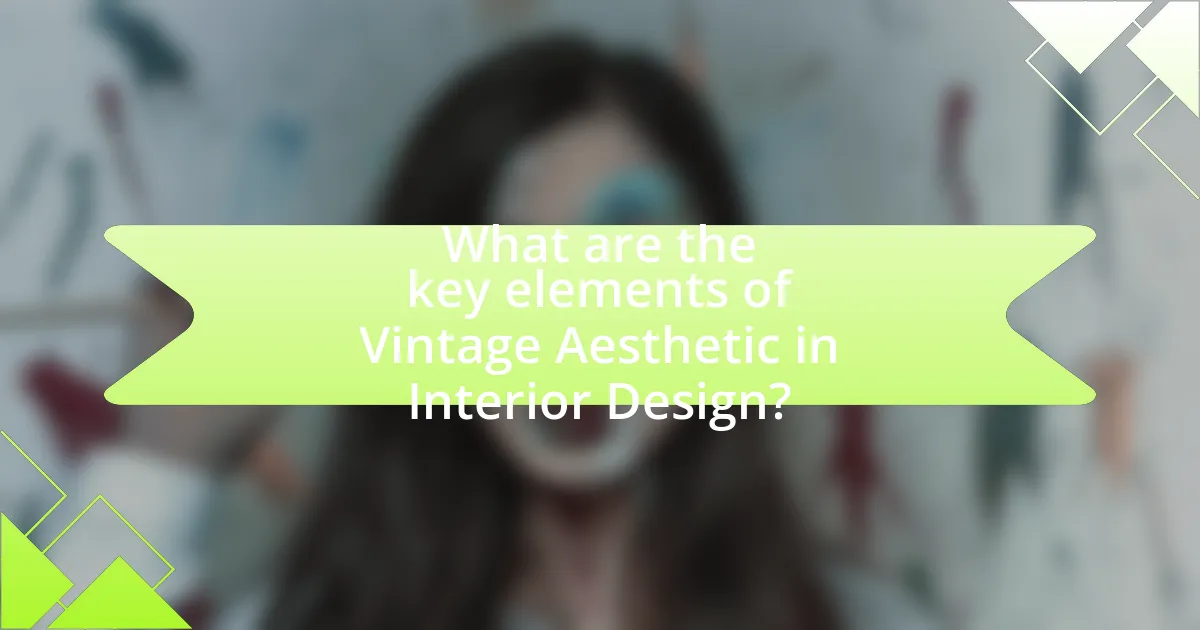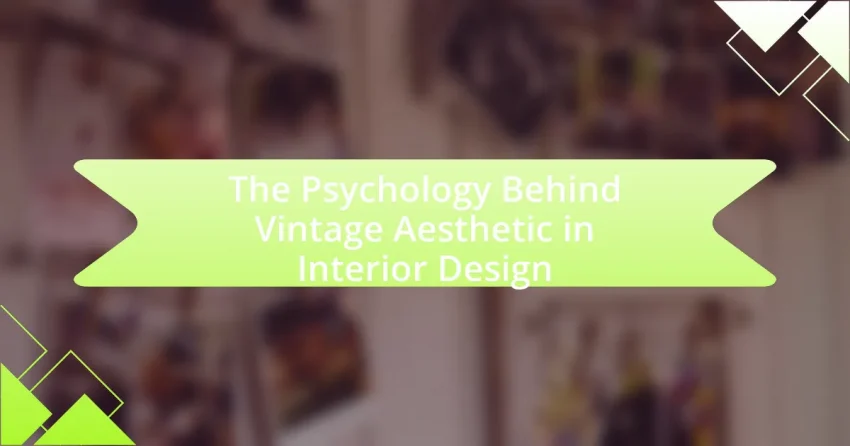The article explores the psychology behind the vintage aesthetic in interior design, highlighting its emphasis on nostalgia and historical significance. It examines the emergence of this style as a reaction to industrialization, the influence of historical design movements, and the emotional connections that vintage elements foster in contemporary spaces. Key aspects discussed include the role of materials, colors, and furniture in creating a vintage atmosphere, as well as the psychological impacts of nostalgia on mood and social connectedness. Additionally, the article provides practical tips for integrating vintage decor into modern interiors while maintaining balance and authenticity.

What is the Vintage Aesthetic in Interior Design?
The Vintage Aesthetic in Interior Design refers to a style that incorporates elements from past decades, typically emphasizing nostalgia and historical significance. This aesthetic often features antique furniture, retro color palettes, and decorative items that evoke a sense of history and warmth. The use of vintage pieces can create a unique character in a space, as they often tell a story and reflect personal or cultural heritage. Research indicates that environments designed with vintage elements can enhance emotional well-being by fostering a sense of comfort and familiarity, which is rooted in psychological principles of nostalgia and memory.
How did the vintage aesthetic emerge in interior design?
The vintage aesthetic emerged in interior design as a response to the rapid industrialization and mass production of the mid-20th century, which led to a desire for nostalgia and authenticity in home decor. This movement gained traction in the 1980s and 1990s, influenced by a growing interest in historical styles and the preservation of older furniture and decor items. The rise of thrift stores and flea markets provided access to unique, character-rich pieces, further popularizing the vintage look. Additionally, the vintage aesthetic is often associated with emotional connections to the past, as it evokes memories and a sense of comfort, making it appealing in contemporary design.
What historical influences shaped the vintage aesthetic?
The vintage aesthetic is shaped by historical influences such as the Arts and Crafts Movement, Art Deco, and mid-century modernism. The Arts and Crafts Movement, which emerged in the late 19th century, emphasized handcrafted goods and a return to traditional craftsmanship, influencing the appreciation for vintage items. Art Deco, popular in the 1920s and 1930s, introduced bold geometric designs and luxurious materials, contributing to the allure of vintage decor. Mid-century modernism, spanning the 1940s to 1960s, celebrated simplicity and functionality, further embedding vintage styles into contemporary design. These movements collectively fostered a nostalgic appreciation for past aesthetics, making them integral to the vintage aesthetic in interior design.
How do different eras contribute to the vintage style?
Different eras contribute to the vintage style by providing distinct design elements, materials, and aesthetics that reflect the cultural and technological advancements of their time. For instance, the Art Deco period of the 1920s introduced geometric patterns and luxurious materials, while the Mid-Century Modern era of the 1950s emphasized clean lines and functional design. Each era’s unique characteristics influence contemporary vintage aesthetics, allowing designers to blend historical elements with modern sensibilities. The popularity of vintage style in interior design often stems from a desire to evoke nostalgia and connect with the past, as seen in the resurgence of retro furnishings and color palettes that mirror those from earlier decades.
Why is the vintage aesthetic appealing to homeowners?
The vintage aesthetic is appealing to homeowners because it evokes nostalgia and a sense of comfort associated with the past. This aesthetic often incorporates elements that remind individuals of their childhood or significant historical periods, creating emotional connections that enhance the living environment. Research indicates that nostalgia can increase feelings of belonging and improve mood, making spaces designed with vintage elements more inviting and emotionally satisfying. For instance, a study published in the journal “Emotion” found that nostalgic memories can foster social connectedness and increase feelings of warmth, which homeowners seek to replicate in their interiors.
What psychological factors drive the attraction to vintage design?
The attraction to vintage design is primarily driven by nostalgia, a psychological phenomenon that evokes fond memories of the past. Nostalgia creates a sense of comfort and belonging, often linked to positive emotions associated with earlier life stages or cultural eras. Research indicates that nostalgia can enhance mood and increase feelings of social connectedness, making vintage items appealing as they serve as tangible connections to cherished memories. Additionally, the uniqueness and craftsmanship of vintage pieces often evoke a sense of authenticity and individuality, contrasting with mass-produced modern designs. This desire for authenticity is supported by studies showing that consumers increasingly value unique and meaningful products, which vintage designs inherently provide.
How does nostalgia play a role in the vintage aesthetic?
Nostalgia significantly influences the vintage aesthetic by evoking emotional connections to the past, which enhances the appeal of vintage design elements. This emotional response is rooted in the human tendency to reminisce about simpler times, often associated with comfort and familiarity. Research indicates that nostalgia can increase feelings of social connectedness and improve mood, making vintage aesthetics particularly attractive in interior design. For instance, a study published in the journal “Emotion” by Wildschut et al. (2006) found that nostalgic memories can foster a sense of belonging and continuity, which aligns with the warm, inviting qualities often found in vintage interiors. Thus, nostalgia not only shapes preferences for vintage styles but also enriches the overall experience of a space.

What are the key elements of Vintage Aesthetic in Interior Design?
The key elements of Vintage Aesthetic in Interior Design include antique furniture, retro color palettes, nostalgic decor, and textured fabrics. Antique furniture, often sourced from the mid-20th century or earlier, serves as focal points, while retro color palettes typically feature muted tones like mustard yellow, olive green, and dusty rose, evoking a sense of nostalgia. Nostalgic decor items, such as vintage posters, old photographs, and classic collectibles, enhance the theme by creating a connection to the past. Textured fabrics, including velvet, lace, and worn leather, add depth and warmth to the space, reinforcing the vintage feel. These elements collectively create an inviting atmosphere that resonates with memories and history, appealing to the emotional aspects of interior design.
What types of furniture are commonly used in vintage design?
Vintage design commonly features furniture such as mid-century modern chairs, antique wooden tables, and retro sofas. These types of furniture are characterized by their unique styles, materials, and craftsmanship that reflect specific historical periods. For instance, mid-century modern chairs often showcase clean lines and organic forms, while antique wooden tables may exhibit intricate carvings and traditional joinery techniques. The use of retro sofas, often upholstered in bold fabrics, adds a nostalgic touch that resonates with the vintage aesthetic. This furniture selection not only enhances the visual appeal of a space but also evokes a sense of history and nostalgia, which is a key aspect of the vintage design philosophy.
How do materials and textures enhance the vintage look?
Materials and textures enhance the vintage look by evoking a sense of nostalgia and authenticity. Natural materials such as wood, leather, and metal, often show signs of wear and age, which contribute to the character and charm associated with vintage aesthetics. For example, reclaimed wood beams or distressed leather furniture not only provide tactile richness but also tell a story of their past, making spaces feel more inviting and lived-in. Textures like aged fabrics or patinated metals further amplify this effect, as they create visual interest and depth, reinforcing the idea of timelessness in design. Historical trends, such as the Arts and Crafts movement, emphasized handcrafted materials, which are now sought after for their unique imperfections that enhance the vintage appeal.
What role do colors play in creating a vintage atmosphere?
Colors play a crucial role in creating a vintage atmosphere by evoking nostalgia and a sense of history. Specific hues such as muted pastels, earthy tones, and rich jewel colors are often associated with different historical periods, helping to transport individuals to those times. For example, soft pinks and greens can reflect the 1950s, while deep burgundies and golds may evoke the opulence of the Victorian era. Research indicates that color perception is closely linked to emotional responses; thus, these vintage colors can trigger memories and feelings associated with the past, enhancing the overall aesthetic. The use of these colors in interior design can effectively create a cohesive vintage look that resonates with the desired emotional experience.
How can vintage decor be integrated into modern spaces?
Vintage decor can be integrated into modern spaces by strategically combining vintage pieces with contemporary design elements. This approach allows for a harmonious blend that enhances the aesthetic appeal of the space while maintaining functionality. For instance, incorporating a vintage armchair alongside a sleek modern sofa creates a focal point that adds character without overwhelming the room. Additionally, using vintage accessories, such as lamps or artwork, can introduce warmth and nostalgia, which contrasts effectively with minimalist modern furnishings. Studies show that mixing styles can evoke positive emotional responses, as vintage elements often trigger memories and a sense of comfort, thereby enriching the overall atmosphere of modern interiors.
What are the best practices for mixing vintage and contemporary styles?
The best practices for mixing vintage and contemporary styles include selecting a cohesive color palette, balancing proportions, and incorporating statement pieces. A cohesive color palette ensures that both vintage and contemporary elements complement each other, creating a harmonious look. Balancing proportions involves pairing larger vintage furniture with sleek contemporary pieces to avoid visual clutter. Incorporating statement pieces, such as a bold vintage artwork or a contemporary sculpture, can serve as focal points that unify the design. These practices are supported by design principles that emphasize harmony and contrast, which are essential for creating a visually appealing space.
How can one maintain balance when incorporating vintage elements?
To maintain balance when incorporating vintage elements, one should blend vintage pieces with modern design elements to create harmony. This approach allows for the preservation of the nostalgic appeal of vintage items while ensuring that the overall aesthetic remains cohesive and contemporary. For instance, pairing a vintage armchair with a modern coffee table can create a visually appealing contrast that enhances the space. Research indicates that a balanced mix of old and new can evoke positive emotional responses, as it combines familiarity with freshness, appealing to both nostalgia and modern sensibilities.

What psychological impacts does the vintage aesthetic have on individuals?
The vintage aesthetic positively impacts individuals by evoking feelings of nostalgia and comfort. This aesthetic often reminds people of simpler times, which can reduce stress and anxiety levels. Research indicates that nostalgia can enhance mood and increase feelings of social connectedness, as seen in a study published in the journal “Emotion” by Wildschut et al. (2006), where participants reported higher levels of happiness and a sense of belonging when exposed to nostalgic stimuli. Additionally, the vintage aesthetic can foster a sense of identity and personal history, allowing individuals to connect with their past and create a more meaningful living space.
How does vintage design influence mood and emotions?
Vintage design significantly influences mood and emotions by evoking nostalgia and comfort. This aesthetic often incorporates elements from past eras, which can trigger positive memories and feelings of warmth, leading to a sense of belonging and security. Research indicates that nostalgia can enhance mood and increase feelings of social connectedness, as demonstrated in a study published in the journal “Emotion” by Wildschut et al. (2006), which found that nostalgic recollections can improve mood and foster a sense of continuity in life. Therefore, vintage design not only beautifies spaces but also plays a crucial role in shaping emotional experiences through its connection to personal and collective histories.
What feelings are commonly associated with vintage interiors?
Vintage interiors commonly evoke feelings of nostalgia, comfort, and warmth. These emotions arise from the association of vintage elements with personal memories and historical contexts, creating a sense of familiarity and connection to the past. Research indicates that nostalgia can enhance mood and increase feelings of social connectedness, as seen in studies by Batcho (1995) which highlight nostalgia’s role in emotional well-being. Additionally, the use of warm colors and textured materials in vintage design contributes to a cozy atmosphere, further reinforcing feelings of comfort and relaxation.
How does the vintage aesthetic promote comfort and relaxation?
The vintage aesthetic promotes comfort and relaxation by evoking nostalgia and familiarity, which can create a sense of emotional security. This aesthetic often incorporates warm colors, soft textures, and familiar patterns that remind individuals of simpler times, contributing to a calming atmosphere. Research indicates that environments designed with vintage elements can reduce stress and enhance feelings of well-being, as they often reflect personal memories and cultural heritage. For example, a study published in the Journal of Environmental Psychology found that nostalgic elements in design can lead to increased feelings of comfort and a decrease in anxiety levels.
What are the social implications of adopting a vintage aesthetic?
Adopting a vintage aesthetic has significant social implications, including the promotion of nostalgia and the reinforcement of cultural identity. This aesthetic often evokes memories of past eras, fostering a sense of belonging and continuity among individuals who resonate with those historical contexts. Research indicates that nostalgia can enhance social connectedness and emotional well-being, as seen in studies like “Nostalgia: A Psychological Resource” by Wildschut et al., which highlights how nostalgic experiences can strengthen social bonds and provide comfort during times of uncertainty. Furthermore, embracing vintage styles can challenge contemporary consumerism by encouraging sustainable practices, as individuals often seek out second-hand items, thereby promoting environmental consciousness and community engagement.
How does vintage design foster a sense of community and belonging?
Vintage design fosters a sense of community and belonging by evoking nostalgia and shared cultural references among individuals. This design style often incorporates elements that resonate with collective memories, such as retro furniture or decor that remind people of their past experiences or familial ties. Research indicates that nostalgia can enhance social connectedness, as it encourages individuals to reflect on shared histories and values, thereby strengthening interpersonal bonds. For instance, a study published in the Journal of Personality and Social Psychology found that nostalgia can increase feelings of social support and belongingness, highlighting its role in fostering community ties.
What role does storytelling play in vintage interior design?
Storytelling plays a crucial role in vintage interior design by creating emotional connections and evoking nostalgia. This design approach often incorporates elements from different historical periods, allowing individuals to engage with personal or collective memories associated with those times. For instance, the use of antique furniture or retro decor can transport occupants to a specific era, enhancing their emotional experience within the space. Research indicates that environments rich in narrative elements can significantly influence mood and well-being, as they resonate with personal histories and cultural stories. Thus, storytelling in vintage interior design not only shapes aesthetic choices but also fosters a deeper sense of belonging and identity.
What practical tips can help in achieving a vintage aesthetic?
To achieve a vintage aesthetic, incorporate elements such as antique furniture, retro color palettes, and vintage accessories. Antique furniture, often characterized by its craftsmanship and unique designs, serves as a focal point in vintage decor. Using retro color palettes, like muted pastels or earthy tones, can evoke a sense of nostalgia and warmth, reminiscent of past eras. Additionally, vintage accessories, including old photographs, vintage textiles, and classic lighting fixtures, enhance the overall ambiance and authenticity of the space. These elements collectively create a cohesive vintage aesthetic that reflects historical styles and personal memories.
How can one source authentic vintage pieces effectively?
To source authentic vintage pieces effectively, one should prioritize reputable vintage shops, estate sales, and online marketplaces specializing in vintage items. These venues often provide a curated selection of genuine pieces, ensuring authenticity through established relationships with collectors and sellers. For instance, shops that have been in business for several years typically have a reputation for quality and authenticity, while estate sales often feature items with verifiable provenance. Additionally, online platforms like Etsy and 1stDibs allow users to filter for verified sellers, increasing the likelihood of finding authentic vintage items.
What are some common mistakes to avoid when designing with a vintage aesthetic?
Common mistakes to avoid when designing with a vintage aesthetic include overloading a space with too many vintage items, which can create visual clutter and detract from the intended nostalgic feel. Additionally, failing to balance vintage pieces with modern elements can lead to a disjointed look; incorporating contemporary items can enhance the overall design. Another mistake is neglecting the importance of color harmony; using clashing colors can disrupt the cohesive vintage vibe. Lastly, ignoring the scale and proportion of vintage furniture can result in awkward layouts, as oversized pieces may overwhelm a small space while undersized items can get lost in larger areas.
